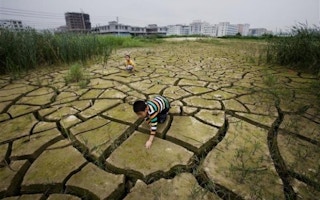Global warming threatens China’s march to prosperity by cutting crops, shrinking rivers and unleashing more droughts and floods, says the government’s latest assessment of climate change, projecting big shifts in how the nation feeds itself.
The warnings are carried in the government’s “Second National Assessment Report on Climate Change,” which sums up advancing scientific knowledge about the consequences and costs of global warming for China — the world’s second biggest economy and the biggest emitter of greenhouse gas pollution.
Global warming fed by greenhouse gases from industry, transport and shifting land-use poses a long-term threat to China’s prosperity, health and food output, says the report. With China’s economy likely to rival the United States’ in size in coming decades, that will trigger wider consequences.
“China faces extremely grim ecological and environmental conditions under the impact of continued global warming and changes to China’s regional environment,” says the 710-page report, officially published late last year but released for public sale only recently.
Even so, China’s rising emissions of carbon dioxide, the main greenhouse gas from burning fossil fuels, will begin to fall off only after about 2030, with big falls only after mid-century, says the report.
Assuming no measures to counter global warming, grain output in the world’s most populous nation could fall from 5 to 20 percent by 2050, depending on whether a “fertilization effect” from more carbon dioxide in the air offsets losses, says the report.
But that possible fall can be held in check by improved crop choice and farming practices, as well as increased irrigation and fertilizer use.
China is the world’s biggest consumer of cereals and has increasingly turned to foreign suppliers of corn and soy beans.
The report was written by teams of scientists supervised by government officials, and follows up on a first assessment released in 2007. It does not set policy, but offers a basis of evidence and forecasts that will shape policy.
Water, either too much or too little, lies at the heart of how that warming could trip up China’s budding prosperity.
Threats to food security
“Climate change will lead to severe imbalances in China’s water resources within each year and across the years. In most areas, precipitation will be increasingly concentrated in the summer and autumn rainy seasons, and floods and droughts will become increasingly frequent,” says the report.
“Without effective measures in response, by the latter part of the 21st century, climate change could still constitute a threat to our country’s food security,” it says.
Under one scenario of how global warming will affect water availability, by 2050 eight of mainland China’s 31 provinces and provincial-status cities could face severe water shortages — meaning less than 500 cubic meters per resident — and another 10 could face less dire chronic shortages.
In low-lying coastal regions, rising seas will press up against big cities and export zones that have stood at the forefront of China’s industrialization.
China’s efforts to protect vulnerable coastal areas with embankments are inadequate, says the report, noting their vulnerability to typhoons and flood tides that global warming could intensify.
There are sure to be shifts in Chinese crop patterns as well, says the report. More rice and other crops will probably grow in the northeast, thanks to warmer weather and possibly more rain. In the northwest cotton-growing region of Xinjiang, shrinking water availability could lead to a “marked decline in agricultural crop productivity”.
China, with 1.34 billion people, already emits a quarter of the world’s CO2, with the United States the world’s second largest greenhouse gas emitter.
China’s emissions, which grew 10 percent in 2010 according to BP, are likely to start falling only after 2030, the report says. It says China’s emissions reduction efforts up to 2020 will cost 10 trillion yuan ($1.6 trillion), including 5 trillion yuan for energy-saving technology and new and renewable energy.










